Related Research Articles

Blue is one of the three primary colours in the RYB colour model, as well as in the RGB (additive) colour model. It lies between violet and cyan on the spectrum of visible light. The term blue generally describes colours perceived by humans observing light with a dominant wavelength that’s between approximately 450 and 495 nanometres. Most blues contain a slight mixture of other colours; azure contains some green, while ultramarine contains some violet. The clear daytime sky and the deep sea appear blue because of an optical effect known as Rayleigh scattering. An optical effect called the Tyndall effect explains blue eyes. Distant objects appear more blue because of another optical effect called aerial perspective.

Ultramarine is a deep blue color pigment which was originally made by grinding lapis lazuli into a powder. Its lengthy grinding and washing process makes the natural pigment quite valuable—roughly ten times more expensive than the stone it comes from and as expensive as gold.

A pigment is a powder used to add color or change visual appearance. Pigments are completely or nearly insoluble and chemically unreactive in water or another medium; in contrast, dyes are colored substances which are soluble or go into solution at some stage in their use. Dyes are often organic compounds whereas pigments are often inorganic. Pigments of prehistoric and historic value include ochre, charcoal, and lapis lazuli.

Basic copper carbonate is a chemical compound, more properly called copper(II) carbonate hydroxide. It is an ionic compound consisting of the ions copper(II) Cu2+
, carbonate CO2−
3, and hydroxide OH−
.

Malachite is a copper carbonate hydroxide mineral, with the formula Cu2CO3(OH)2. This opaque, green-banded mineral crystallizes in the monoclinic crystal system, and most often forms botryoidal, fibrous, or stalagmitic masses, in fractures and deep, underground spaces, where the water table and hydrothermal fluids provide the means for chemical precipitation. Individual crystals are rare, but occur as slender to acicular prisms. Pseudomorphs after more tabular or blocky azurite crystals also occur.
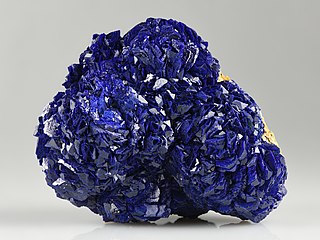
Azurite is a soft, deep-blue copper mineral produced by weathering of copper ore deposits. During the early 19th century, it was also known as chessylite, after the type locality at Chessy-les-Mines near Lyon, France. The mineral, a basic carbonate with the chemical formula Cu3(CO3)2(OH)2, has been known since ancient times, and was mentioned in Pliny the Elder's Natural History under the Greek name kuanos (κυανός: "deep blue," root of English cyan) and the Latin name caeruleum. Copper (Cu2+) gives it its blue color.

Oil paint is a type of slow-drying paint that consists of particles of pigment suspended in a drying oil, commonly linseed oil. The viscosity of the paint may be modified by the addition of a solvent such as turpentine or white spirit, and varnish may be added to increase the glossiness of the dried oil paint film. The addition of oil or alkyd medium can also be used to modify the viscosity and drying time of oil paint. Oil paints were first used in Asia as early as the 7th century AD and can be seen in examples of Buddhist paintings in Afghanistan. Oil-based paints made their way to Europe by the 12th century and were used for simple decoration, but oil painting did not begin to be adopted as an artistic medium there until the early 15th century. Common modern applications of oil paint are in finishing and protection of wood in buildings and exposed metal structures such as ships and bridges. Its hard-wearing properties and luminous colors make it desirable for both interior and exterior use on wood and metal. Due to its slow-drying properties, it has recently been used in paint-on-glass animation. The thickness of the coat has considerable bearing on the time required for drying: thin coats of oil paint dry relatively quickly.
Copper carbonate may refer to :

Verdigris is a common name for any of a variety of somewhat poisonous copper salts of acetic acid, which range in colour from green to a bluish-green depending on their chemical composition. Once used as a medicine and pharmaceutical preparation, Verdigris occurs naturally, creating a patina on copper, bronze, and brass, and is the main component of a historic green pigment used for artistic purposes from antiquity until the late 20th century, including in easel painting, polychromatic sculptures, and illumination of maps. However, due to its instability, its popularity declined as other green pigments became readily available. The instability of its appearance stems from its hydration level and basicity, which changes as the pigment interacts with other materials over time.

Copper(II) hydroxide is the hydroxide of copper with the chemical formula of Cu(OH)2. It is a pale greenish blue or bluish green solid. Some forms of copper(II) hydroxide are sold as "stabilized" copper(II) hydroxide, although they likely consist of a mixture of copper(II) carbonate and hydroxide. Cupric hydroxide is a strong base, although its low solubility in water makes this hard to observe directly.

Paris green is an arsenic-based organic pigment. As a green pigment it is also known as Mitis green, Schweinfurt green, Sattler green, emerald, or Vienna green, Emperor green or Mountain green. It is a highly toxic emerald-green crystalline powder that has been used as a rodenticide and insecticide, and also as a pigment. It was manufactured in 1814 to be a pigment to make a vibrant green paint, and was used by many notable painters in the 19th century. The color of Paris green is said to range from a pale blue green when very finely ground, to a deeper green when coarsely ground. Due to the presence of arsenic, the pigment is extremely toxic and in paintings, the color can degrade quickly.
Lapis armenus, also known as Armenian stone or lapis stellatus, in natural history, is a variety of precious stone, resembling lapis lazuli, except that it is softer, and instead of veins of pyrite, is intermixed with green. "The Armenian stone" is so similar to lapis lazuli that it has often not been distinguished from it; Webster's Revised Unabridged Dictionary for instance treats the two terms as synonyms. The Dictionary of Traded Goods and Commodities 1550-1820 defines lapis armenus as
Armenian stone, or azurite, a naturally occurring basic copper carbonate, originally from Armenia, but later from Germany, from which blue bice was prepared. It was often found in association with another copper carbonate, malachite from which green bice was prepared... Probably because they were both blue, blue bice was sometimes misinterpreted to mean lapis lazuli.
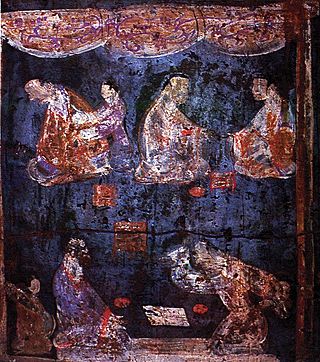
Han purple and Han blue are synthetic barium copper silicate pigments developed in China and used in ancient and imperial China from the Western Zhou period until the end of the Han dynasty.
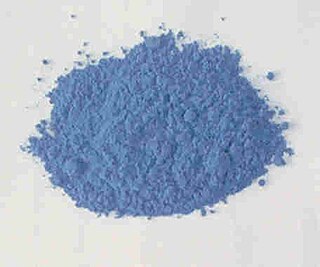
Egyptian blue, also known as calcium copper silicate (CaCuSi4O10 or CaOCuO(SiO2)4 (calcium copper tetrasilicate)) or cuprorivaite, is a pigment that was used in ancient Egypt for thousands of years. It is considered to be the first synthetic pigment. It was known to the Romans by the name caeruleum. After the Roman era, Egyptian blue fell from use and, thereafter, the manner of its creation was forgotten. In modern times, scientists have been able to analyze its chemistry and reconstruct how to make it.

Chalconatronite is a carbonate mineral and rare secondary copper mineral that contains copper, sodium, carbon, oxygen, and hydrogen, its chemical formula is Na2Cu(CO3)2•3(H2O). Chalconatronite is partially soluble in water, and only decomposes, although chalconatronite is soluble while cold, in dilute acids. The name comes from the mineral's compounds, copper ("chalcos" in Greek) and natron, naturally forming sodium carbonate. The mineral is thought to be formed by water carrying alkali carbonates (possibly from soil) reacting with bronze. Similar minerals include malachite, azurite, and other copper carbonates. Chalconatronite has also been found and recorded in Australia, Germany, and Colorado.
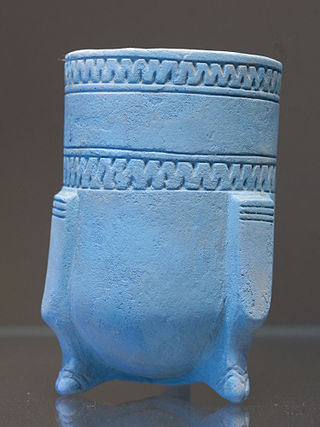
The colour blue has been important in culture, politics, art and fashion since ancient times. Blue was used in ancient Egypt for jewellery and ornament. In the Renaissance, blue pigments were prized for paintings and fine blue and white porcelain. in the Middle Ages, deep rich blues made with cobalt were used in stained glass windows. In the 19th century, the colour was often used for military uniforms and fashion.

Blue pigments are natural or synthetic materials, usually made from minerals and insoluble with water, used to make the blue colors in painting and other arts. The raw material of the earliest blue pigment was lapis lazuli from mines in Afghanistan, that was refined into the pigment ultramarine. Since the late 18th and 19th century, blue pigments are largely synthetic, manufactured in laboratories and factories.
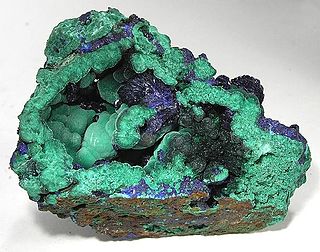
Green pigments are the materials used to create the green colors seen in painting and the other arts. Most come from minerals, particularly those containing compounds of copper. Green pigments reflect the green portions of the spectrum of visible light, and absorb the others. Important green pigments in art history include Malachite and Verdigris, found in tomb paintings in Ancient Egypt, and the Green earth pigments popular in the Middle Ages. More recent greens, such as Cobalt Green, are largely synthetic, made in laboratories and factories.

Azurite is an inorganic pigment derived from the mineral of the same name. It was likely used by artists as early as the Fourth Dynasty in Egypt, but it was less frequently employed than synthetically produced copper pigments such as Egyptian Blue. In the Middle Ages and Renaissance, it was the most prevalent blue pigment in European paintings, appearing more commonly than the more expensive ultramarine. Azurite's derivation from copper mines tends to give it a greenish hue, in contrast with the more violet tone of ultramarine. Azurite is also less stable than ultramarine, and notable paintings such as Michelangelo's The Entombment have seen their azure blues turn to olive green in time. Azurite pigment typically includes traces of malachite and cuprite; both minerals are found alongside azurite in nature, and they may account for some of the green discoloration of the pigment. The particle size of azurite pigment has been shown to have a significant effect on its chromatic intensity, and the manner of grinding and preparing the pigment therefore has a major impact on its appearance.
References
- ↑ One or more of the preceding sentences incorporates text from a publication now in the public domain : Chisholm, Hugh, ed. (1911). "Bice". Encyclopædia Britannica . Vol. 3 (11th ed.). Cambridge University Press. p. 911.
- ↑ HMC 9th Report: Canterbury (London, 1883), p. 150.
- ↑ Roskill & Hand, ed., Hans Holbein, Paintings, Prints, and Reception (Yale, 2001), p. 119.
- ↑ Basil Stallybrass, 'Bess of Hardwick's Building Accounts', Archaeologia, 64 (1913), pp. 382–84
- ↑ Bristow, Ian C., Interior house-Painting Colours and Technology, 1615-1640 (Yale, 1996), p. 17.
- ↑ Chapter 9 of "The Treasure Seekers" by E.Nesbit